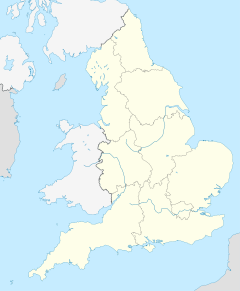Batley
| Batley | ||
|---|---|---|
| Hanging Heaton, St. Paul's Church | ||
| Coordinates | 53 ° 43 ′ N , 1 ° 38 ′ W | |
| OS National Grid | SE245245 | |
|
|
||
| Residents | 49,448 (as of April 29, 2001) | |
| administration | ||
| Post town | BATLEY | |
| ZIP code section | WF17 | |
| prefix | 01924 | |
| Part of the country | England | |
| region | Yorkshire and the Humber | |
| Shire county | West Yorkshire | |
| District | Kirklees | |
| British Parliament | Batley and Spen | |
| Website: batley.com | ||
Batley is a medium-sized town in the Metropolitan Borough of Kirklees the English county of West Yorkshire . According to the 2001 census, it had a total of 49,448 inhabitants.
history
Batley is first mentioned as Bathelie in the Domesday Book around 1100 and had about 30 to 40 residents at that time; by the end of the 14th century the population of the village grew to about 100. A church has existed in Batley since the 12th century. Today's church building dates from the time of King Henry VI. (1422–1461), otherwise little building fabric from the Middle Ages has been preserved in the city . In the 1580s, Sir John Savile , one of the most important country nobles of Yorkshire, had Howley Hall built in Batley as his country residence. In 1611, Rev. William Lee had the Batley Grammar School built, which still exists today. In the 1940s, the Methodists found their way into Batley, which subsequently developed into a Methodist stronghold. It is also due to their influence that there are no pubs in some areas of the city .
After the place was dominated by agriculture for centuries, industrialization began in 1796 with the first water-powered wool spinning machine . The number of residents now rose sharply; around 1200 there were 2500 and in 1851 already 9308, including the neighboring towns of Morley, Churwell and Gildersome, which were now assigned to the Batley parish, even 17,359 people lived in Batley. A large part of the population was now active in textile processing. In 1832 Batley was connected to the Chausseestrasse system, which benefited sales of wool products. Since there were repeated strikes in the textile factories, Irish workers were called to the community and settled there permanently. Initially, this was associated with tensions within the city, including religious ones, but these soon subsided. In 1870 the Catholics also got their own church with Mary of the Angels. In 1848 Batley was connected to the railway network and in 1853 also its own town hall - the current one dates from 1905. In 1868 Batley was granted town status as a Municipal Borough .
In 1853 Michael Spedding opened a candy store in Batley, which eventually became one of the largest employers in town alongside Tesco under the name Fox's Biscuit . Textile production specialized in shoddy goods, remnants of wool from old clothes that were reused to make sheets, shawls and uniforms. In 1861 there were no fewer than 30 shoddy mills in Batley, which helped some entrepreneurs, the "shoddy barons", to great fortune. Even the Methodist Zion Chapel, built in 1870, was nicknamed the “Shoddy Temple”. In 1907, Andrew Carnegie donated a library to the city. In 1937 the neighboring village of Birstall was incorporated. In addition to the textile industry, coal mining also played a certain role, which had been in operation in White Lee since the 16th century. In 1973 the last coal mine in Batley ceased operations.
After the Second World War , it was mainly Indians and Pakistanis who immigrated, who were in demand as cheap labor in the textile industry. Today 45% are of Asian origin. Numerous Asian specialty shops, restaurants and six mosques testify to the presence of this population group. As part of local government reform of 1974, Batley was assigned to the Metropolitan Borough of Kirklees.
Sport and culture
Batley is home to the Batley Bulldogs rugby club.
In the center of the city is Wilton Park, a green area that also houses an observatory built in 1966 and the Bigshaw Museum. The museum houses exhibits on the history of the city, on ancient Egyptian history and from the field of natural science; it is named after the first curator, Walter Bagshaw, who was Batley councilor and has traveled widely. There is a permanent art exhibition in the city library, which exhibits works by contemporary painters, sculptors and photographers. The Batley Variety Club has long been known nationwide as a venue where, among others, Johnny Mathis , Eartha Kitt , The Bee Gees , Roy Orbison , The Hollies and Cliff Richard performed; today there is a night club there.
In popular culture
- In Monty Python's Flying Circus , the Batley Women's Guild reenacted famous battles, such as: B. Pearl Harbor .
- Batley is the location of the children's program My Spy Family .
- Batley was the location of the 1955 film Value for Money with John Gregson and Diana Dors .
Personalities
- Joseph Priestley (1733–1804), chemist, attended school here
Sons and daughters
- Lawrence Rickard Wager (1904–1965), geologist, researcher and mountaineer
- Hugh Garner (1913–1979), Canadian writer of British descent
- Robert Edwards (1925–2013), medical doctor and Nobel Prize winner
- Robert Palmer (1949–2003), musician
- Jo Cox (1974-2016), Labor politician
Individual evidence
- ↑ Office for National Statistics: Census 2001: Urban Areas: Table KS01: Usual Resident Population.Retrieved August 26, 2009
Web links
- The City website (English)

